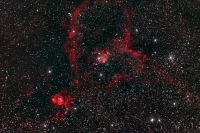Tom How spent a night over the Bank Holiday weekend at the NFO where he had a good play with the mini-WASP array – I was attempting (half satisfactorily) to polar align the Hyperstar III in the south dome. Meanwhile Tom in the North dome was collecting some quite nice Heart nebula data from Camera 1 of the two camera system. This image shows about an hour’s worth of data collected using the Sky 90 with IDAS filter and an SXVF-M26C 10 Megapixel one-shot colour camera. The camera has not yet been collimated which explains the star shape changes across the FOV. However – the camera response is much as I have seen previously with the M25C (bigger pixels) and so it proves as I had anticipated, that I will not see any reduction in sensitivity with the smaller M26C pixels as I am working at a pretty short focal length. So – a step up from 6 Megapixels to 10 Megapixels and then times 2 for two cameras – this mini-WASP array will be producing some amazing data when it is all tuned up.
So what more needs to be done before we can see the full power of the mini-WASP array? Not a great deal really:
1) Properly focus train and collimate both cameras.
2) Align cameras for slight overlap so that I can take a 4 x 3.33 degree field of view in one go.
3) Take some new flats with a properly collimated system.
4) Focus train for the H-alpha, H-beta, SII and OIII filters.
And that should be it for a while 🙂


